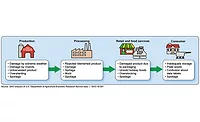Food Loss & Waste: It’s Everywhere in the Supply Chain
Food loss and waste (FLW) happens on every-level in the supply chain. The impacts of FLW are devastating and, thankfully, can be avoided through swift and direct action on every level.

Food loss and waste happens on every-level in the supply chain. The impacts of FLW are devestating and, thankfully, can be avoided through swift and direct action on every level. Image courtesy of Ben Kerckx from Pixabay
Food loss and waste (FLW) happens everywhere from farm to fork, and there’s plenty of blame to go around. An estimated $600 billion worth of food is lost globally during or just after harvest, according to a recent McKinsey & Company report.1 In the U.S., about 30% of surplus food in grocery stores goes into landfills, causing a loss of $16 billion a year, according to a recent study from Coresight Research.2 Overall, Americans waste an average of 80 billion pounds of food per year, amounting to a value of approximately $161 billion, according to the Center for Nutrition Studies.3 Based on its data, Coresight did the math and found that American consumers waste $218 billion’s worth of food annually—or an average of $1,600 in produce per household.
No matter the data source (e.g., UN’s FAO, U.S. Department of Agriculture, McKinsey, Coresight), and while the numbers may not all perfectly align, it’s easily apparent that FLW is too high. What it comes down to is that 33% to 40% of the world’s food is lost or wasted every year, yet one in nine of the world’s population can’t get enough to eat—that’s equivalent to 800 million suffering from hunger.
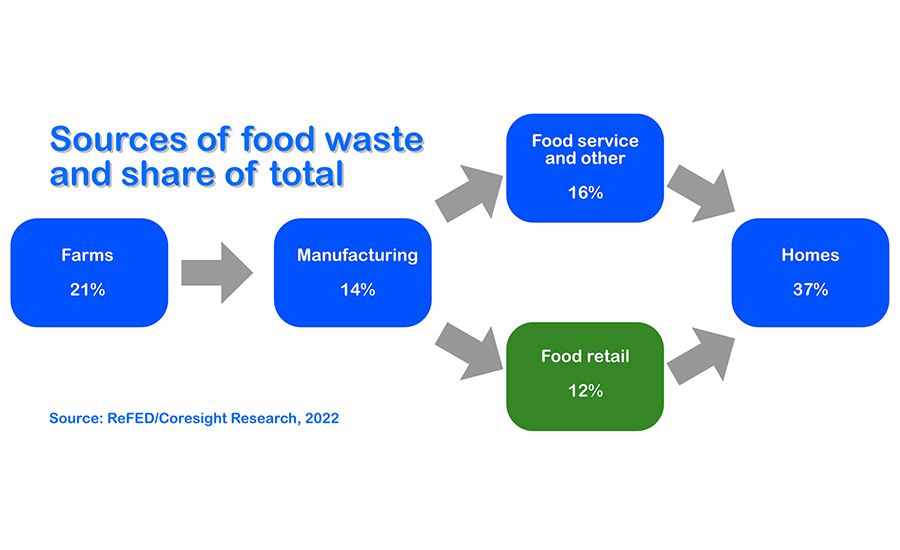 According to the Coresight Research study, food waste at home accounts for 37% of total FLW while farms is the second biggest culprit at 21%.Image courtesy ReFED Coresight Research
According to the Coresight Research study, food waste at home accounts for 37% of total FLW while farms is the second biggest culprit at 21%.Image courtesy ReFED Coresight Research
Who’s to Blame for FLW
The FAO defines food waste as “the discard of edible foods at the retail and consumer levels” and food loss as happening upstream or “the decrease in edible food mass at the production, post-harvest and processing stages of the food chain.” While consumers are blamed for wasting as much as 37% of the food in the American supply chain, the Coresight study says that farms contribute to 21% of waste; manufacturing 14%; food service 16%; and food retail 12%.
FLW occurs at differing rates, depending on product and distribution. In the McKinsey report, for example, field-grown tomatoes were tracked from farm to the retailer. Starting with 100 tomatoes ready for harvest, only 73 to 81 survive the harvest operation. Next, one or two tomatoes are lost on their way to handling and grading. After handling and grading, 67 to 77 tomatoes survive and go on to processing and packaging. Finally, only 59 to 72 tomatoes make it to the retailer. At this point some tomatoes will not be sold—either due to visual appearance or quickly approaching sell-by dates.
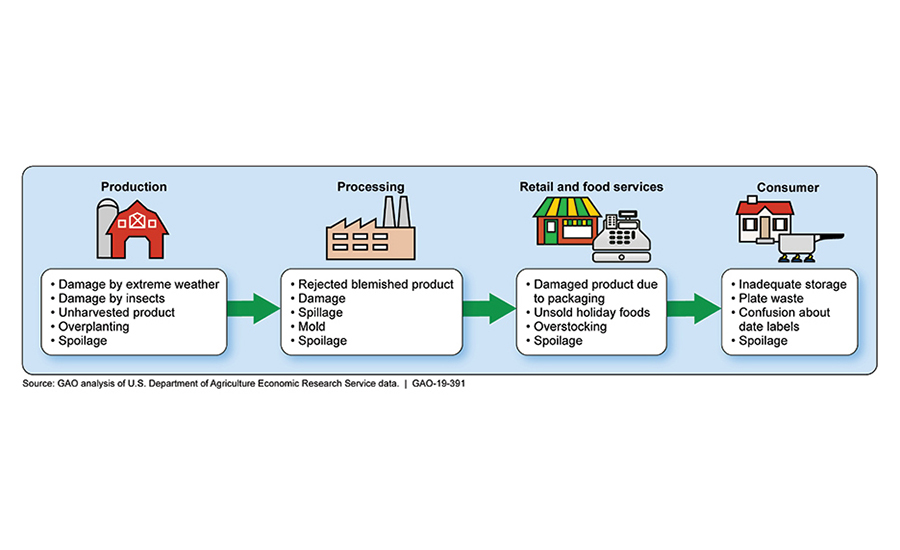 FLW can occur at any point in the food supply chain. According to the Coresight Research study, more than one-fifth of food never makes it off the farm premises. Produce can be spoiled by insects, animals and weather—and in many cases too much is planted, which can result in unharvested product, especially if there is a labor shortage.Image courtesy U.S. GAO
FLW can occur at any point in the food supply chain. According to the Coresight Research study, more than one-fifth of food never makes it off the farm premises. Produce can be spoiled by insects, animals and weather—and in many cases too much is planted, which can result in unharvested product, especially if there is a labor shortage.Image courtesy U.S. GAO
Local Fixes
Some retailers are now working with volunteer groups (especially in urban areas) to shift unspoiled, slightly out-of-date tomatoes and other produce to people who have been hit with food insecurity. There are other options for decreasing waste. One example is the increase of vertical farming to bring the growing of produce closer to the markets they serve, cutting supply chain distances. A glance at the June Annual Plant Construction Survey shows an increase in vertical farming for quick-to-spoil produce.
Other options for farms that are forward thinking (actually what some farms practiced decades ago) include the processing of imperfect or about-to-spoil tomatoes right at the farm level or nearby processing plant into another product—like canned tomatoes, sauce or tomato juice. There is another alternative for “ugly” or imperfect tomatoes in some urban areas where startup companies (e.g., Misfits Market in Philadelphia) are snagging misshaped, over- or undersized, short-dated or out-of-date produce from farms and/or retailers to sell and distribute locally at a lower price, which provides opportunities for lower-income people to have perfectly edible produce at a lower price.
Processing plants don’t necessarily have to be within a few miles of farms—if the resulting product doesn’t have to look like the original produce. An example of this is the Heinz ketchup plant in the Netherlands, which receives a large share of its tomato input from Spain, nearly 1,000 miles away. Farms in Spain, whose tomatoes are not suitable for retail, ship them in bulk for processing into ketchup or sauce.
Turn Food Loss Into Wins
Since food loss happens mostly at the farm level, addressing the issue will require mindset shifts by all stakeholders, says the McKinsey report. Food manufacturers and retailers need to see food loss as a result of inefficiencies and missed opportunities across production, procurement, R&D, the supply chain and sales. Therefore, reducing food loss should be seen as a potential value—an opportunity to improve both the top and bottom lines.
Quantifying and identifying food loss is not an exact science, but steps can be taken to map food loss “hot spots” in the supply chain and understand their causes. Rather than wait for perfect data, supply chain stakeholders should gather enough information to sense the scope of their problem. McKinsey research found four areas to curb losses (which could help reduce upstream loss by 50% to 70%):
- Minimize production/processing loss
- Minimize transit loss
- Sell more of what is produced and processed
- Structurally prevent loss
Regardless of the chosen course(s) of action, each company in the supply chain must change the way it interacts with other stakeholders. McKinsey suggests working with suppliers to better match supply and demand, overhauling procurement practices, finding creative ways to turn food loss into value and getting total participation from the C-suite.
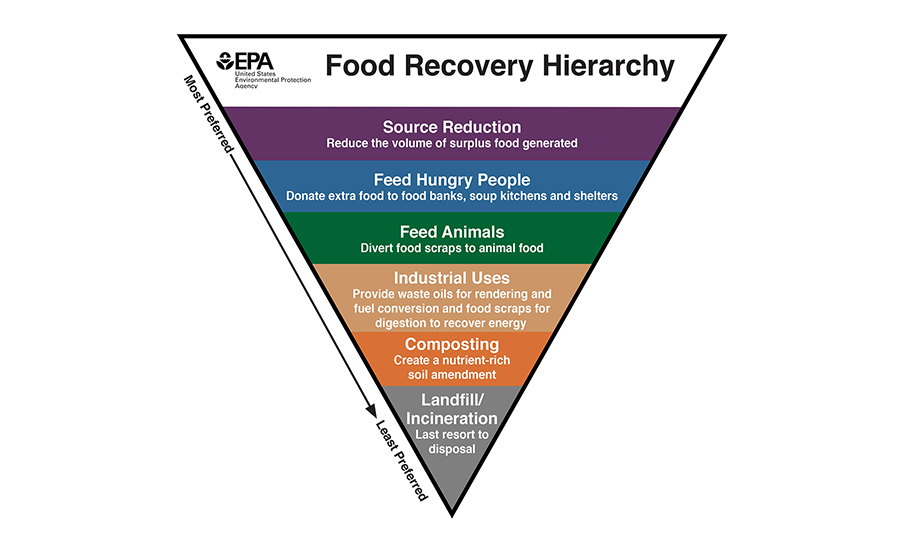 The EPA’s Food Recovery Hierarchy shows the most preferred methods of reducing FLW, beginning with reducing the volume of surplus food generated, then feeding hungry people—and the least preferred, sending food to a landfill. Image courtesy U.S. EPA
The EPA’s Food Recovery Hierarchy shows the most preferred methods of reducing FLW, beginning with reducing the volume of surplus food generated, then feeding hungry people—and the least preferred, sending food to a landfill. Image courtesy U.S. EPAGrocery Level Issues: Defining the Specifics of Waste
According to Coresight Research, much of food waste can be avoided by the use of technology. In its study concentrating on grocery retailers, loss at this level was $482 billion, reported in 2021.
Kroger, the U.S.’s largest pure-play grocer, reported a 22% gross margin and a 20% tax rate in fiscal 2021, according to Coresight Research. Applying these figures to its estimate of $482 billion in food waste, grocery retailers could increase their net income by $16 billion, which is meaningful in an industry estimated to have generated about $25 billion in net income in 2021, according to Coresight. Grocery retailers face additional costs related to collecting wasted food and paying for its hauling and disposal in landfills.
The Coresight survey asked grocery retailers for their definition of food waste. The results varied. For example, 42% of retailers define food waste as unsold food, 14.4% say it is unsold food either thrown away or sent to a landfill, 67.7% say it is prepared food discarded due to overproduction or over ordering while 63%, however, view food waste reduction as very important in meeting corporate sustainability goals. Subsequent questions in the survey defined food waste as part of shrink (inventory lost due to spoilage and expiration, theft, inaccurate shipments and miscounting).
The Coresight study found a recurring theme throughout its interviews with grocery retailers, and it generally comes down to a lack of actionable information. The report makes several recommendations, most of which are based on having more useful data. For example:
- The grocery retail industry needs to adopt common metrics for food waste to bring attention to the issue and enable comparison across companies.
- Food waste, expiration and spoilage are sources of shrink that can be measured and reduced.
- Grocery retailers have little visibility or control of how much donated, discounted or returned food is actually eaten or disposed of in a landfill.
- Overproduction and over ordering are situations that can be mitigated with more accurate demand forecasting.
- More than half of all grocery retailers lack the technology to prioritize food waste.
- Grocery retailers need to empower an individual with responsibility and the power to manage food waste across the entire organization and make the organization changes necessary to achieve their food-waste goals.
- Grocery retailers’ top opportunities to reduce shrink from unsold food include freshness tracking and discounting, which go hand in hand.
Coresight’s survey found that 84% of respondents plan to invest in technology over the next two years to manage food waste. Grocery retailers have diverse reasons for investing in this technology, with meeting sustainability goals being the top response.
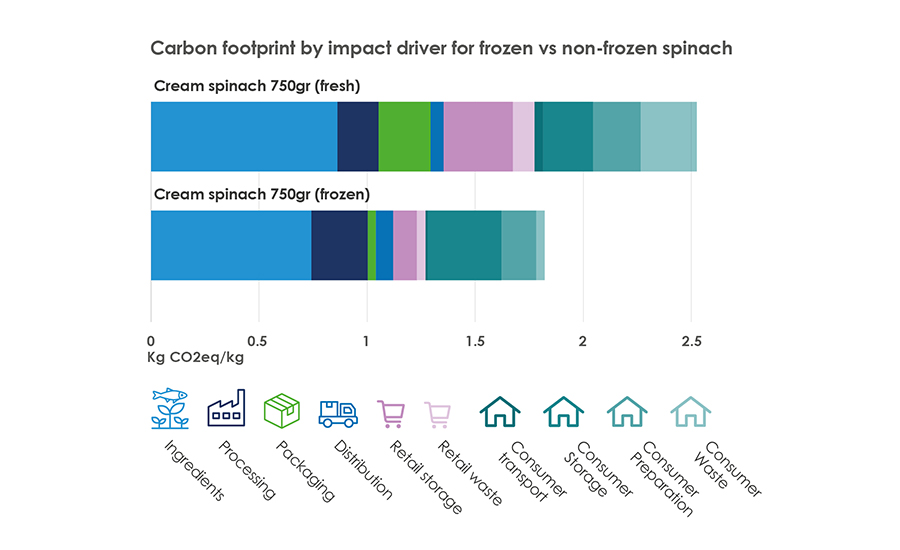 In this comparison provided by Nomad Foods (UK) and research entity PRé Sustainability, two methods of making creamed spinach are shown according to their carbon footprint—in this case, fresh and frozen. Research found that there was more consumer waste in preparing creamed spinach from scratch than purchasing and preparing a frozen ready-to-heat product.Image courtesy Business Wire
In this comparison provided by Nomad Foods (UK) and research entity PRé Sustainability, two methods of making creamed spinach are shown according to their carbon footprint—in this case, fresh and frozen. Research found that there was more consumer waste in preparing creamed spinach from scratch than purchasing and preparing a frozen ready-to-heat product.Image courtesy Business Wire Demand and Forecasting: Technologies that Can Help
Using technology to get control of demand and forecasting is key in reducing needless waste in the food supply chain. Today’s AI and machine learning (ML) techniques are being used to predict demand and supply patterns, process improvements, workforce planning, task allocation and scheduling in the manufacturing phase, according to Sunil Kardam, head, logistics and supply chain management, and client partner, Gramener, a company specializing in advanced data analytics solutions to forecast demand, plan capacity, and augment supply. These analytics include, for example, market data, consumer studies and social media.
It’s the market data that lets processors know what’s hot or trending at any given moment, and demand planning software can make use of that data to ensure processors and retail order the right ingredients/products, says Joe Scioscia, VP at VAI, an ERP supplier. For example, says Scioscia, if people are trying to eat healthier, there’s a good chance there will be a spike in almond milk sales, so there may be a downward trend in dairy milk sales, in which case demand planning software can pick up on a healthy trend.
But how can these technologies be applied to make better planning and purchasing decisions? Kardam offers the following: For example, social listening may alert us to a new rage—gluten-free burger buns. A consumer survey may reveal that burgers are preferred as a breakfast option on working days. Market data may show a seasonal demand for black burger buns around Halloween. Scouting around for alternatives to wheat, barley and rye used for burger buns may throw up options like rice, tapioca, potato starch and corn starch—and suppliers have to be identified. Production and logistics have to be scheduled for timely delivery to ensure early morning stocking of shelves. Sustainable food coloring like squid ink and activated bamboo charcoal should be sourced. Most importantly, machine settings have to be recalibrated to work well with new ingredients.
Therefore, Kardam suggests that a mix of qualitative and quantitative methods will ensure a firm grip on forecasting despite supply chain irregularities. “Historical data helps us learn from experience, while consumer and market sentiments give us expert insights. We use data analytics to augment supply chain visibility and optimize costs and cost relationships,” adds Kardam.
It’s the market data that lets processors know what’s hot or trending at any given moment, and demand planning software can make use of that data to ensure processors and retail order the right ingredients/products, says Joe Scioscia, VP at VAI, an ERP supplier. For example, says Scioscia, if people are trying to eat healthier, there’s a good chance there will be a spike in almond milk sales, so there may be a downward trend in dairy milk sales, in which case demand planning software can pick up on a healthy trend.
But how can these technologies be applied to make better planning and purchasing decisions? Kardam offers the following: For example, social listening may alert us to a new rage—gluten-free burger buns. A consumer survey may reveal that burgers are preferred as a breakfast option on working days. Market data may show a seasonal demand for black burger buns around Halloween. Scouting around for alternatives to wheat, barley and rye used for burger buns may throw up options like rice, tapioca, potato starch and corn starch—and suppliers have to be identified. Production and logistics have to be scheduled for timely delivery to ensure early morning stocking of shelves. Sustainable food coloring like squid ink and activated bamboo charcoal should be sourced. Most importantly, machine settings have to be recalibrated to work well with new ingredients.
Therefore, Kardam suggests that a mix of qualitative and quantitative methods will ensure a firm grip on forecasting despite supply chain irregularities. “Historical data helps us learn from experience, while consumer and market sentiments give us expert insights. We use data analytics to augment supply chain visibility and optimize costs and cost relationships,” adds Kardam.
Supply Chain Stakeholders at Least Need the Basics
While not every supply chain stakeholder will be ready for the most advanced demand planning systems, there’s no reason that companies should not have the basics as they’re affordable and can function in the cloud, making no heavy-duty IT investment necessary, says VAI’s Scioscia. This means investing in tracking systems so processors know where their products or ingredients are at any given time and their status, for example, temperature, time on the road, etc.
But these tracking systems can do more than just track a product in transit. Plant managers automatically scan ingredients in the warehouse and when it’s time to use them, they know the full history and shelf life of the ingredient—so they know whether to use it or discard it, says Scioscia. When all the ingredients are mixed and combined into a single product, should a recall be necessary, it will be much easier to find all the manufactured product in the market plus know which ingredient may be at fault. Today, processors can’t be without this information. And during a recall, this technology could make it possible to trace bad products in the marketplace in an hour or two as opposed to a couple days or weeks. In addition, by making lots of smaller-sized batches, should a recall be necessary, waste can be held to a minimum, due to the granularity of the number of smaller batches.
References
[1] “Reducing food loss: What grocery retailers and manufacturers can do;” McKinsey & Company; Borens, Gatzner, Magnin and Timelin; 9-2022
[2] “Overcoming the Food-Waste Challenge: Improving Profit Wile Doing Good,” Deborah Weinswig, CEO and founder, Coresight Research, 22 June 2022
[3] “Reducing Food Waste Across the Supply Chain: Statistics & Strategies,” Theresa Houghton, Center for Nutrition Studies, 7 July 2021
Looking for a reprint of this article?
From high-res PDFs to custom plaques, order your copy today!




